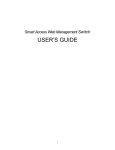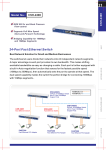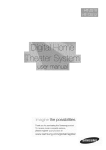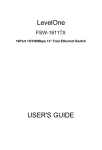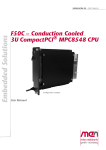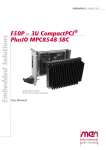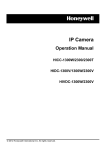Download LevelOne USER'S GUIDE
Transcript
LevelOne FSW-2411TX 24port 10/100Mbps 13” Fast Ethernet Switch USER'S GUIDE FCC WARNING This equipment has been tested and found to comply with the limits for a Class A computing device pursuant to Part 15 of FCC Rules, which are designed to provide reasonable protection against electromagnetic interference in a commercial environment. Changes or modifications to the equipment not expressly approved by the party responsible for compliance could void the user's authority to operate the equipment. CE MARK WARNING THIS IS A CLASS A PRODUCT. IN A DOMESTIC ENVIRONMENT THIS PRODUCT MAY CAUSE RADIO INTERFERENCE IN WHICH CASE THE USER MAY B E REQUIRED TO TAKE ADE QUATE MEASURES . 2 T ABLE OF C ONTENTS UNPACKING INFORMATION-----------------------------------4 PRODUCT INTRODUCTION-------------------------------------5 FAST ETHERNET TECHNOLOGY-------------------------------------------- 5 SWITCHING TECHNOLOGY----------------------------------------------------5 FEATURES---------------------------------------------------------------------------6 THE FRONT PANEL---------------------------------------------------------------7 CABLING------------------------------------------------------------------------------8 STATUS LEDS----------------------------------------------------------------------8 THE REAR PANEL-----------------------------------------------------------------8 INSTALLATION-----------------------------------------------------------10 TO LOCATE THE SWITCH ON A DESKTOP-----------------------------10 TO STACK YOUR SWITCH----------------------------------------------------10 RACKMOUNT PLACEMENT-------------------------------------------------- 10 HELPFUL SUGGESTIONS --------------------------------------12 Prior to Installation----------------------------------------------------------------12 Half- and Full-Duplex------------------------------------------------------------ 12 Fast Ethernet-----------------------------------------------------------------------13 Auto-Negotiation-------------------------------------------------------------------13 MAC Address Table--------------------------------------------------------------14 Sample Application---------------------------------------------------------------15 Troubleshooting--------------------------------------------------------16 PRODUCT SPECIFICATIONS --------------------------------17 3 A. UNPACKING INFORMATION Thank you for purchasing LevelOne FSW-2411TX 24 port 10/100Mbps 13” Fast Ethernet Switch. Before continuing, please check the contents of the product package. This product package should contain the following items: Ø One LevelOne FSW-2411TX 24 port 10/100Mbps 13” Fast Ethernet Switch Ø One Power Cord Ø Four Rubber Feet (for desktop placement) Ø One Rackmount Kit Ø Four Stackable stand Ø User’s Guide If anything is missing, please contact your place of purchase. 4 B. PRODUCT INTRODUCTION This chapter describes the features of the Switch and some background information about Ethernet/Fast Ethernet switching technology. Fast Ethernet Technology The growing importance of LANs and the increasing complexity of desktop computing applications are fueling the need for high performance networks. A number of high-speed LAN technologies have been proposed to provide greater bandwidth and improve client/server response times. Among them, 100BASE-T (Fast Ethernet) provides a non-disruptive, smooth evolution from the current 10BASE-T technology. The non-disruptive and smooth evolution nature, and the dominating potential market base, virtually guarantee cost effective and high performance Fast Ethernet solutions in the years to come. 100Mbps Fast Ethernet is a new standard specified by the IEEE 802.3 LAN committee. It is an extension of the 10Mbps Ethernet standard with the ability to transmit and receive data at 100Mbps, while maintaining the CSMA/CD Ethernet protocol. Since the 100Mbps Fast Ethernet is compatible with all other 10Mbps Ethernet environments, it provides a straightforward upgrade and takes advantage of the existing investment in hardware, software, and personnel training. Switching Technology Another approach to pushing beyond the limits of Ethernet technology is the development of switching technology. A switch bridge Ethernet packets at the MAC address level of the Ethernet protocol transmitting among connected Ethernet or Fast Ethernet LAN segments. Switching is a cost-effective way of increasing the total network capacity available to users on a local area network. A switch increases capacity and decreases network loading by dividing a local area network into different segments, which don’t compete with each other for network transmission capacity. 5 The switch acts as a high-speed selective bridge between the individual segments. The switch, without interfering with any other segments, automatically forwards traffic that needs to go from one segment to another. By doing this the total network capacity is multiplied, while still maintaining the same network cabling and adapter cards. For Fast Ethernet networks, a switch is an effective way of eliminating problems of chaining hubs beyond the “two-repeater limit.” A switch can be used to split parts of the network into different collision domains, making it possible to expand your Fast Ethernet network beyond the 205-meter network diameter limit for 100BASE-TX networks. Switches supporting both traditional 10Mbps Ethernet and 100Mbps Fast Ethernet are also ideal for bridging between the existing 10Mbps networks and the new 100Mbps networks. Switching LAN technology is a marked improvement over the previous generation of network bridges, which were characterized by higher latencies. Routers have also been used to segment local area networks, but the cost of a router, the setup and maintenance required make routers relatively impractical. Today switches are an ideal solution to most kinds of local area network congestion problems. Features The Switches were designed for easy installation and high performance in an environment where traffic on the network and the number of user increase continuously. These Switches provide immediate access to a rapidly growing network through a wide range of user-reliable functions. The Switches are ideal for deployment with multiple high-speed servers for shared bandwidth 10Mbps or 100Mbps workgroups. With the highest bandwidth 200Mbps (100Mbps full-duplex mode), any port can provide workstations with a congestion-free data pipe for simultaneous access to the server. The Switches are expandable by cascading two or more switches together. As all ports support 200Mbps, the Switches can be cascaded from any port and to any number of switches. 6 The LevelOne FSW-2411TX 24port 10/100Mbps 13” Fast Ethernet Switch are a perfect choice for site planning to upgrade to Fast Ethernet in the future. Ethernet workgroups can connect to the Switches now, and change adapters and hubs anytime later without needing to change the Switches or reconfigure the network. The Switches combine dynamic memory allocation with store-andforward switching to ensure that the buffer is effectively allocated for each port, while controlling the data flow between the transmit and receive nodes to guarantee against all possible packet loss. The LevelOne FSW-2411TX 24 port 10/100Mbps 13” Fast Ethernet Switch are an unmanaged 10/100 Fast Ethernet Switch that offers solutions in accelerating small Ethernet workgroup bandwidth. Other key features are: l l l l l l l Twenty-four 100/10Mbps Switch ports. Store-and-Forward technology. Auto-Negotiation support for each TP port. IEEE 802.3x Flow-Control support for Full-Duplex operation. Back-Pressure support for Half-Duplex operation. Bridging capability for 100Mbps and 10Mbps segments. All ports support Auto-MDIX function. The Front Panel LevelOne 24 port 10/100Mbps 13” Fast Ethernet Switch Port Speeds 100/10Mbps TP Ports Each 100/10Mbps TP port provides an Auto-Negotiation function that senses for the attached device's maximum operating speed and automatically sets the Switch to operate at that speed. Users only need to connect a network device into any TP port. 7 Cabling 10Mbps – Category 3, 4, or 5 TP cabling can be used for transmitting data at 10Mbps or 20Mbps bandwidth on 10BASE-T networks. 100Mbps – Only Category 5 TP cabling can be used for transmitting data at 100Mbps or 200Mbps bandwidth on 100BASE-TX networks. Port Type Cable Type Connector 10BASE-T Category 3, 4 or 5 TP RJ-45 100BASE-TX Category 5 TP RJ-45 Note: Category 5 TP cable should be used whenever installing new TP cabling. Status LEDs This LevelOne 24 port 10/100Mbps 13” Fast Ethernet Switch comes with a complete range of LEDs. The table below lists each LED’s name, color and a brief description of its function. • One for power On/Off • One per port for Link/Activity • One per port for Full-Duplex/Collision NAME COLOR PWR Green • Lit: Power "On" FUNCTION LINK/ACT Green • Lit: When the port has a valid physical connection (Link) with another device. • Blinks: When the port is sending or receiving data (Activity). FD/COL Amber • Lit: When the port is set to Full-Duplex mode. • Blinks: When a collision is detected,in Half-Duplex mode. The Rear Panel 8 Power Socket The Power Socket is designed to be used with the power cord included in the product package. . Attach the female end of the cord to the power connector on the back panel. . Attach the male end of the cord to a grounded power outlet. Fan Note: Please keep the fan area clear, so that the cooling function is not impaired. 9 C. INSTALLATION This LevelOne 24 port 10/100Mbps 13” Fast Ethernet Switch is "Plug & Play." They do NOT require software configuration. Users can immediately use any of the features of this product simply by attaching the cables and turning on the power. TO LOCATE THE Switch ON A DESKTOP a) Attach the four rubber feet included in the product package to the bottom of the Switch, one in each corner. b) Place the Switch on a clean, flat desk or table top close to a power outlet. C) Plug in all network connections and the power cord To stack your Switch a) Attach the four stackable stand included in the product package to the bottom of the Switch, one in each corner. b) Now , you can can use the switch to stack with other switch with stackable stand. C) Plug in all network connections and the power cord RACKMOUNT PLACEMENT This LevelOne 24 port 10/100Mbps 13” Fast Ethernet Switch can be mounted in an EIA standard-sized 19-inch rack. 1. Attach one (1) rackmounting bracket on each side of the Switch’s front panel with the provided screws. 10 2. Use the other provided screws to secure the Switch to the rack. 11 D. HELPFUL SUGGESTIONS Prior to Installation Before installing the Switch and connecting network devices, it is important to plan the network's layout. Things you should consider include: . Dedicated Bandwidth: File servers and other high-traffic hardware improve their performance if they have their own dedicated 10Mbps or 100Mbps bandwidth. . Full-Duplex: Determine which devices support Full-Duplex connections. . Fast Ethernet: Make sure rules for cable lengths and categories are followed. . Auto-Negotiation: Devices with different speeds may be easily swapped when the other end of the cable is fixed to a port with AutoNegotiation. Half- and Full-Duplex This LevelOne 24Port 10/100Mbps 13” Fast Ethernet Switch supports both Half- and Full-Duplex modes for 10BASE-T and 100BASE-TX. • In Half-Duplex mode data cannot be transmitted and received at the same time. Attached devices must finish transmitting data before they can receive data. • In Full-Duplex mode data can be transmitted and received at the same time. 12 However: a) Full-Duplex transmission is only possible between two devices with a dedicated link (e.g., Switch-Switch, Switch-PC) b) Both devices must have Full-Duplex capability c) Both devices must be set to Full-Duplex (e.g. AutoNegotiation – Auto-Negotiation, Non-Auto-Negotiation to NonAuto-Negotiation) • The 100BASE-TX/10BASE-T ports on the Switch detect and set the line's operating mode by using their Auto-Negotiation function. Fast Ethernet 100BASE-TX is called "Fast Ethernet". In Fast Ethernet data travels ten times faster (100Mbps) than in traditional Ethernet (10Mbps). Below is a list of the cable types and connectors supported by the Switch for 10BASE-T and 100BASE-TX networks. Port Type 10BASE-T 100BASE-TX Cable Type Category 3, 4 or 5 TP Cat. 5 TP Connector RJ-45 RJ-45 Note: If your 10BASE-T network currently uses Category 5 TP cabling, you can instantly upgrade the network to a 100BASE-TX network by changing network devices. Auto-Negotiation Every 100/10Mbps dual speed port on this LevelOne FSW-2411TX 24 port 10/100Mbps 13” Fast Ethernet Switch has a built-in "AutoNegotiation" function. This technology automatically sets the best possible bandwidth as soon as a connection is established with another network device (usually at Power “On” or Reset). This capability is achieved via the Switch’s Auto-Negotiation function that automatically detects the modes and speeds the second (attached) device is capable of. Evaluating Auto-Negotiation Capability: 13 If the attached device is: This Switch Will Automatically Set Its TP Ports to Operate At: 100Mbps, no Auto-Negotiation 100Mbps Bandwidth (100BASE-TX, Half-Duplex) 100Mbps, with Auto-Negotiation 200Mbps Bandwidth (100BASE-TX, Full-Duplex) 10Mbps, no Auto-Negotiation 10Mbps Bandwidth (10BASE-T, Half-Duplex) 10Mbps, with Auto-Negotiation 20Mbps Bandwidth (10BASE-T, Full-Duplex) F Helpful Warning: If the attached device is set to a fixed mode (ex: Forced Full-Duplex) it will not operate as an Auto-Negotiation device. MAC Address Table Every Ethernet data packet includes both source and destination addresses. This 6-byte ID is called the MAC (Media Access Control) Address. The Switch can automatically learn and store MAC addresses. However, the MAC address table is volatile: it disappears when the Switch is powered “Off” or reset. Note: When the network needs reconfiguration, we recommend to restart switch first. After all nodes have been moved, Remove the power cord and re-attach it on the back panel to rebuild the internal MAC address table. 14 Sample Application The optimal application for this Switch is to interconnect file servers with other bandwidth-hungry workgroups, departments, and offices all with dedicated bandwidths. 15 8 Gigabit ports Switch Mail Server with Gigabit Ethernet Adapter 24 100/10 ports with 2 Gigabit ports switch 24-Port + 2 Giga Port Switch File Server with Gigabit Ethernet Adapter 24 ports 100/10Mbps Fast Ethernet Switch 24 ports 100/10Mbps Fast Ethernet Switch Printer Server 5 Por t Sw 5 ports 100/10Mbps Fast Ethernet Switch i tc h 5 4 3 2 1 16 ports 100/10Mbps Fast Ethernet Switch 8 ports 100/10Mbps Fast Ethernet Switch Workstations with 100/10 Fast Ethernet Adapters Workstations with 100/10 Fast Ethernet Adapters Workstations with 100/10 Fast Ethernet Adapters Workstations with 100/10 Fast Ethernet Adapters E. Troubleshooting I. Link LED does not lit after cable is connected to the port. Ø Verify that the other end of the cable is connected to a 16 device that is powered on and on-line. II. 100BASE-TX port Link LED is lit, Collision LED is blinking, but traffic is irregular. Ø Check that the attached device is not set to dedicated Full-Duplex. (Some devices use a physical or software switch to change Duplex modes. Auto-Negotiation may not recognize this type of Full-Duplex setting). ALWAYS CHECK THAT: Ø CABLE AND LINK DISTANCES ARE WITHIN THE NETWORK'S SPECIFICATIONS Ø OVERALL NETWORK DIAMETERS NETWORK'S SPECIFICATIONS 17 ARE WITHIN THE F. PRODUCT SPECIFICATIONS Models Standards Ports Media Support Bandwidth Forwarding/Filtering Rate Latencys MAC Addresses Buffer Memory Duplex Modes Crossover LED Indicators Power Supply Power Consumption FSW-2411TX 10/100Mbps 13” Fast Ethernet Switch 10BASE-T IEEE 802.3 100BASE-TX IEEE 802.3u Twenty-four 100BASE-TX 10BASE-T Category 3, 4 or 5 TP 100BASE-TX Category 5 TP 100BASE-TX 200/100/20/10Mbps 148,810 packets/second per port @ 100Mbps, max. 14,881 packets/second per port @ 10Mbps, max. 9 µsec @100Mbps, minimum 70 µsec @ 10Mbps, minimum 8K six (6)-bytes entries maximum, self-learning 2.5Mb Auto-Negotiation All the TP ports support Auto-MDIX function One for Power One per port for Link / ACT One per port for Full-Duplex /Collision Full range Auto-Switching Input voltage: 100 ~ 240 +/-10% VAC/ 50 ~ 60 Hz 21.5 watt max Environment Operating Temp: 0° ~ 45°C (32° ~ 113°F) Storage Temp: -20° ~ 70°C (-4° ~ 158°F) Humidity: 10% ~ 90% non-condensing Certifications FCC Class A CE Mark Dimensions 306x184x44mm(12.05x7.24x1.73inches) 18


















